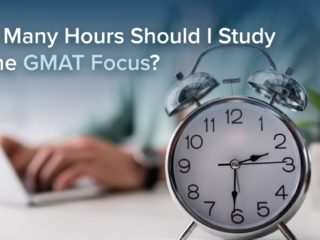Many people planning to apply to MBA programs aim for at least a 90th-percentile score on the GMAT. Per GMAC’s current percentile rankings, scoring in the 90th percentile requires a GMAT total score of 655. (Note that 655 is equivalent to the time-honored target score of 700 on the legacy GMAT.) With that goal in mind, MBA aspirants often wonder, “How many questions can I get wrong on the GMAT and get 655?”
In this article, we’ll answer that question by examining the various factors that affect your GMAT score. Additionally, we’ll explore different scenarios that are likely to result in a 655 GMAT total score.
Here are the topics we’ll cover:
- GMAT Structure and Scoring
- How We Can Determine How Many Questions You Can Miss and Score 655
- How Many Questions Can You Miss on the GMAT and Get 655?
- The Difficulty Levels of the Questions You Can Miss and Score 655
- Key Takeaways
- What’s Next?
Let’s begin by gaining an understanding of how the GMAT is structured and scored.
GMAT Structure and Scoring
To determine how many questions you can get wrong for 655, it helps to understand the GMAT’s structure and scoring.
The GMAT consists of 3 sections: Quantitative Reasoning (Quant), Verbal Reasoning (Verbal), and Data Insights (DI). Each section is associated with a score range of 60 to 90, with scores given in 1-point increments. While you have 45 minutes to complete each section, you’ll face a different number of questions in each section:
- Quant: 21 questions
- Verbal: 23 questions
- Data Insights: 20 questions
Each section is equally weighted in your GMAT total score, which ranges from 205 to 805 in 10-point increments. The GMAT total score is the one we’re concerned with in this article.
KEY FACT:
Each of the 3 GMAT sections factors equally into your total score.
Now that we understand the basics, let’s discuss a key aspect of GMAT scoring that affects how many questions you must correctly answer to get a particular score: computer adaptivity.
The GMAT Is a Computer-Adaptive Test
The GMAT Focus doesn’t calculate your score by simply counting your correct answers in each section. Rather, the scoring process is more complex since the GMAT is a computer-adaptive test.
In simple terms, a computer-adaptive test reacts to the performance of the test-taker. On the GMAT, the difficulty of the questions you see is based on your performance on previous questions. If you get questions correct, you see harder questions. If you get questions incorrect, you see easier questions.
Why does this information matter? It matters because harder questions are worth more than easier questions. So, 2 test-takers who get the same number of questions correct in a section can earn different section scores. Similarly, 2 test-takers who answer the same total number of questions correctly can earn different total scores. As a result, there is not a specific number of correct answers that always produces a score of 655.
Thus, our discussion of how many questions you can miss is going to have to be a little loose. Still, we can get a good idea of how many questions you can get wrong and get 655.
KEY FACT:
Since the GMAT is computer-adaptive, there is not a specific number of correct answers that guarantees a 655 score.
There is one more aspect of GMAT scoring worth noting: the same section scores can produce different total scores. Let’s discuss.
The Same Section Scores Can Be Associated With Different Total Scores
As discussed, your GMAT total score is based on your performance on the Quant, Verbal, and Data Insights sections. So, it’s easy to think that particular section scores are always associated with the same total scores.
However, the same Quant-Verbal-Data Insights breakdown can produce different total scores. For example, Q81/V84/DI82 can be associated with a GMAT Focus total score of 655 or 665. What’s going on?
One way to think about this situation is that section scores represent ranges of performance. For example, our research shows that you can score DI82 with anywhere from 4 to 8 incorrect answers. A DI82 with 8 incorrect answers is not as strong as a DI82 with 4 incorrect answers.
The takeaway? Two test-takers earning the same section score does not indicate that they performed equally well in that section. So, the same 3 section scores yielding different total scores reflects that difference in performance. As we consider how many questions you can miss, we’ll account for this aspect of GMAT Focus scoring.
KEY FACT:
The same Quant-Verbal-Data Insights breakdown can yield different GMAT total scores.
Next, let’s discuss the approach we used to determine how many questions you can miss and score 655 on the GMAT.
How We Can Determine How Many Questions You Can Miss and Score 655
Since the GMAT (Focus) debuted in November 2023, we have collected data from actual GMAT Focus exam scores and official GMAT Prep practice test scores reported by test-takers. This data includes Quant, Verbal, and Data Insights section scores, as well as numbers of incorrect answers.
So, in developing the following scenarios, we used data from the official GMAT Focus scoring algorithm. Keep in mind that these are typical scenarios, not guarantees. As we discussed, it is possible to earn a given section score with different numbers of correct answers.
KEY FACT:
We used official GMAT Focus score data to determine score scenarios that are likely to produce a 655 total score.
With that in mind, let’s examine how many questions you can get wrong on the GMAT and score 655.
How Many Questions Can You Miss on the GMAT and Get 655?
Just as there is no single number of correct answers that guarantees a 655, there is no single section score combination that guarantees a 655. Instead, you can reach 655 with various combinations of Quant, Verbal, and Data Insights scores. In our research, we have determined that a combined section score of 247 is likely to yield a 655 total.
So, we’ll consider 4 scenarios that can produce a combined section score of 247 and thus a 655 GMAT Focus score:
- a balanced scenario in which you perform well on all 3 sections
- a strong Quant scenario in which you perform better on Quant than on Verbal and Data Insights
- a strong Verbal scenario in which you perform better on Verbal than on Quant and Data Insights
- a strong Data Insights scenario in which you perform better on Data Insights than on Quant and Verbal
Let’s examine each scenario in detail.
655 Scenario 1: Balanced
In this scenario, you score 655 on the GMAT Focus with 3 good section performances: Q84/V83/DI80. Note that, although the section scores are different, each score has a similar percentile rank.
Our research indicates that Q84 scores are typically earned with 2 to 4 missed questions. To ensure that this scenario delivers 655, we’ll go with 3 Quant questions missed.
Next, our research indicates that V83 scores are typically earned with 6 or 7 missed questions. To be safe, we’ll say 6 Verbal questions missed.
Finally, a DI80 is typically earned with 6 to 9 missed questions. Again, to make sure that we end up with 655, we’ll go with 7 Data Insights questions missed.
In our balanced scenario, you miss a total of 16 questions to score 655.
In percentage terms, you’d get 18/21, or 86%, of Quant questions correct, 17/23, or 74%, of Verbal questions correct, and 13/20, or 65%, of Data Insights questions correct. Overall, you’d get 48/64, or 75%, of questions correct.
655 Scenario 2: Strong Quant
In this scenario, you score 655 on the GMAT Focus by excelling in Quant and performing solidly in Verbal and Data Insights: Q87/V81/DI79.
Our research indicates that Q87 scores are typically earned with 1 to 3 missed questions. To ensure that this scenario delivers 655, we’ll go with 2 Quant questions missed.
Next, our research indicates that V81 scores are typically earned with 7 to 9 missed questions. To be safe, we’ll say 8 Verbal questions missed.
Finally, a DI79 is typically earned with 7 to 10 missed questions. Again, to make sure that we end up with 655, we’ll go with 8 Data Insights questions missed.
In our “strong Quant” scenario, you miss a total of 18 questions to score 655.
In percentage terms, you’d get 19/21, or 90%, of Quant questions correct, 15/23, or 65%, of Verbal questions correct, and 12/20, or 60%, of Data Insights questions correct. Overall, you’d get 46/64, or 72%, of questions correct.
655 Scenario 3: Strong Verbal
In this scenario, an excellent Verbal score and solid Quant and Data Insights scores earn you a 655 on the GMAT Focus: Q80/V87/DI80.
Our research indicates that Q80 scores are typically earned with 3 to 6 missed questions. To ensure that this scenario delivers 655, we’ll go with 4 Quant questions missed.
Next, our research indicates that V87 scores are typically earned with 3 to 6 missed questions. To be safe, we’ll say 4 Verbal questions missed.
Finally, a DI80 is typically earned with 6 to 9 missed questions. Again, to make sure that we end up with 655, we’ll go with 7 Data Insights questions missed.
In our balanced scenario, you miss a total of 15 questions to score 655.
In percentage terms, you’d get 17/21, or 81%, of Quant questions correct, 19/23, or 83%, of Verbal questions correct, and 13/20, or 65%, of Data Insights questions correct. Overall, you’d get 49//64, or 77%, of questions correct.
655 Scenario 4: Strong Data Insights
In this scenario, an elite Data Insights score, combined with solid Quant and Verbal scores, carries you to a 655 GMAT Focus score: Q80/V80/DI87.
Our research indicates that Q80 scores are typically earned with 3 to 6 missed questions. To ensure that this scenario delivers 655, we’ll go with 4 Quant questions missed.
Next, our research indicates that V80 scores are typically earned with 8 to 10 missed questions. To be safe, we’ll say 9 Verbal questions missed.
Finally, a DI87 is typically earned with 3 to 6 missed questions. Again, to make sure that we end up with 655, we’ll go with 4 Data Insights questions missed.
In our balanced scenario, you miss a total of 17 questions to score 655.
In percentage terms, you’d get 17/21, or 81%, of Quant questions correct, 14/23, or 61%, of Verbal questions correct, and 16/20, or 80%, of Data Insights questions correct. Overall, you’d get 47//64, or 73%, of questions correct.
Summary: 655 Scenarios
The following table summarizes the 4 scenarios discussed above.
| GMAT Focus 655 Scenario | Section Scores | Quant Questions Missed | Verbal Questions Missed | Data Insights Questions Missed | Total Questions Missed |
|---|---|---|---|---|---|
| Balanced | Q84/V83/DI80 | 3 | 6 | 7 | 16 |
| Strong Quant | Q87/V81/DI79 | 2 | 8 | 8 | 18 |
| Strong Verbal | Q80/V87/DI80 | 4 | 4 | 7 | 15 |
| Strong Data Insights | Q80/V80/DI87 | 4 | 9 | 4 | 17 |
Interestingly, regardless of the scenario, the total number of questions you can miss remains about the same, ranging from 15 to 18.
Of course, there are other Q/V/DI breakdowns that produce a 655 GMAT Focus score. For example, Q85/V84/DI78 and Q80/V86/DI82 are both likely to yield a 655 total. You can see many of them by using the TTP GMAT Focus score calculator. Nevertheless, it’s likely that the total number of questions you can miss to get 655 in most of these cases will also be around 15 to 18.
KEY FACT:
You can score 655 with balanced section scores or with a score biased toward one section.
Next, let’s discuss an important consideration in these 655 scenarios: the difficulty levels of the questions you miss.
The Difficulty Levels of the Questions You Can Miss and Score 655
Earlier, we discussed a key factor in the GMAT scoring algorithm: correctly answering hard questions is worth more than getting easy questions correct. As you might suspect, the opposite is true for the questions you get incorrect. Whereas missed hard-level questions won’t hurt your score much, missed easy questions will drag your score down significantly. So, in each scenario, the missed questions we’re talking about are mostly hard questions and some medium questions.
In other words, if you miss easy questions, you likely won’t score 655 on the GMAT with the numbers of missed questions we discussed. In each scenario, you need to get the easy questions and most medium questions correct, in order to score 655.
TTP PRO TIP:
To score 655 on the GMAT Focus, you need to get all or almost all easy questions and most medium questions correct.
Let’s now review what we have learned about scoring 655 on the GMAT.
Key Takeaways
In this article, we have covered several important facts about the number of questions you can get wrong to score 655.
- Each GMAT section (Quant, Verbal, and Data Insights) contributes equally to your total score.
- Because the GMAT is computer adaptive, there is not an exact number of questions you can miss to score 655.
- Similarly, there is not a single combination of section scores that guarantees a 655 total score.
- Our research indicates that a combined section score of 247 is likely to yield a 655 total, and that combined section score can be reached in multiple ways.
- The total number of questions you can miss across all 3 sections to score 655 is likely to fall in the 15 to 18 range.
- To score 655, you need to get almost all easy and most medium questions correct.
What’s Next?
Now that you understand the performance required to score 655 on the GMAT, check out these guides on how to increase your Quant, Verbal, and Data Insights scores.



